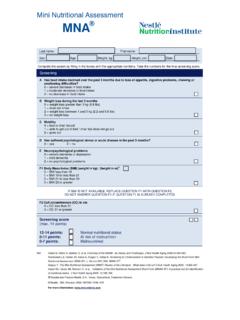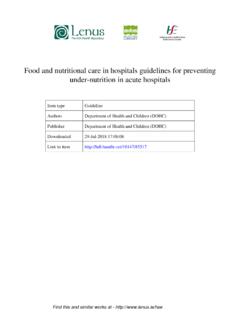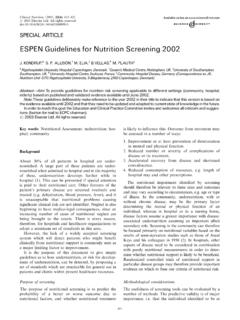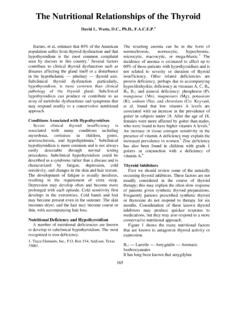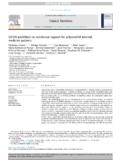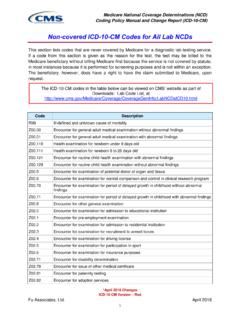Transcription of NUTRITIONAL THERAPY IN HEPATIC FAILURE - …
1 MADELEINE COETZEE ( ) WITS DONALD GORDON MEDICLINIC NUTRITIONAL THERAPY IN HEPATIC FAILURE Cirrhosis is believed to be a state of accelerated starvation Dasarathy, 2014 Treatment: Slow down disease progression Transplant NUTRITIONAL aims: Decompensated disease, septic or Acute Liver FAILURE : aim to maintain muscle mass and slow down rate of malnutrition Compensated patients: Attempt to improve NUTRITIONAL status The liver is crucial for metabolism & storage of nutrients. Function Examples Digestion Fat absorption via bile acid production Carbohydrate metabolism Storage glycogen Mobilisation glucose in response to hypoglyceamia Protein metabolism Utilisation AA for protein synthesis and gluconeogenesis Synthesis of plasma albumin, prothrombin, fibrinogen and clotting factors Detoxify ammonia to urea Fat metabolism Converts FA to acetyl-CoA to produce enegy Synthesis trigyceride, phospholipids, cholesterol Ketogenesis Vitamins Storage fat soluble vitamins and Zn, Cu, Mg.
2 B12 Produce transport proteins for Vit A, Iron, Zn, Cu Convert folate, vit D, carotene to active forms. Detoxification Detoxify alcohol, metabolise drugs and deactivate hormones Immune function Filter bacteria from GI tract Produce cytokines MALNUTRITION IN LIVER DISEASE 80% -100% cirrhotic patients malnourished Malnutrition in cirrhosis is associated with major complications: sepsis ascites HEPATIC encephalopathy (HE) spontaneous bacterial peritonitis Hepato-renal syndrome Above complications occur in 65% of malnourished patients versus 12% of well-nourished patients Malnutrition.
3 Multiple causes for Protein Energy Malnutrition and sarcopenia Reduced intake: Altered taste Nausea and reduced appetite Early satiety from ascites Restricted diets Altered metabolism Hypermetabolism Gluconeogenisis, due to low glucogen stores, rapidly deplete muscle mass Increase myostatin expression (potent negative regulator of skeletal muscle), caused by hyperammonia and higher levels of TNF Hormonal imbalances- low testosterone levels Increased losses: Fat malabsorption Diarrhoea Leaky gut NUTRITIONAL losses from parencentesis MALNUTRITION screening & ASSESSMENT NUTRITIONAL screening needed to identify at risk patients early.
4 NUTRITIONAL assessment complicated due to fluid imbalances and muscle wasting Need to use a variety of tools: Subjective Global Assessment (SGA) complicated and underreports malnutrition in cirrhosis. The Royal Free Hospital- NUTRITIONAL Prioritizing Tool (RFH-NPT). Validated screening tool for HEPATIC FAILURE patients, but more thorough assessment required. The Royal Free Hospital- NUTRITIONAL Prioritizing Tool (RFH-NPT) ASSESSMENT: LEAN BODY MASS Imaging techniques: Cross-sectional CT (L3 or L4 to directly quantify muscle and visceral fat mass.)
5 Expensive and difficult to repeat. Anthropometrics: Triceps skinfold (TSF) fat mass Mid-arm muscle circumference (MAMC) muscle mass. MAMC the most reliable anthropometric tool in cirrhosis (<5th centile = malnourished). Hand-grip dynamometer: Assessment of muscle strength. In cirrhosis: sensitive and specific marker for depletion lean body (more accurate in men than women) Inexpensive tool (<R100) Easy to repeat Muscle function often improve before muscle mass improve. Results seen within days.
6 HEPATIC ENCEPHALOPATHY (HE) HE is a neurological dysfunction affecting primarily the brain, caused my acute or chronic liver insufficiency and/or portosystemic shunting. mortality 42-64% Malnutrition and HE Overt HE significantly more prevalent in patients with muscle depletion (Merli at al, 2013) Incidence HE 46% sarcopenic vs 27% non sarcopenic pts (Kalaitzakis et al, 2007) Previous episodes of HE are likely to worsen sarcopenia by a combination of hyperammonemia, poor oral intake and hospitalisation.
7 NUTRITIONAL treatment important step to improve QOL and survival of chirrotic HE patients ETIOLOGY OF HE IN CIRRHOSIS HE is caused by products that would usually be broken down by the liver (ammonia, certain medication), which enter the systemic circulation, where it may be toxic to the brain. Causes: Metabolic stress (infection, electrolyte imbalace, dehydration) Certain medication (sedatives, alcohol, analgesia) Increase in gut protein GI bleeding High protein diet Treatment: dietary protein should be eliminated.
8 20-40g protein may be allowed in mild (Merck Manual 2006) Protein restriction?! Metabolic stress Increase proteolysis & gluconeogenesis (muscle catabolism) Increase in endogenously produced urea and ammonia Worsen HE Worsen sarcopenia Provide adequate energy and protein Limit Limit Inadequate protein and starvation Worsen Neurotoxic Skeletal muscle has to be preserved to enable clearance of ammonia. Act as a second liver for ammonia clearance. Glutamine synthesis & ammonia clearance low during rest. Ammonia clearance can possible improved by physical activity.
9 Exercise may play role in prevention/treatment of HE. TYPE OF AMINO ACIDS (AA) In cirrhosis: imbalance between BCAA (leucine, isoleucine,valine) and AAA. AAA produce false neurotransmitters (possible cause of neurological dysfunction in HE). Theory: BCAA can prevent HE and improve NUTRITIONAL outcomes Cochrane review 2017: 16 RCT on effect of BCAA on HE: BCAA may have a beneficial effect on HE (duration and severity of HE) , but it has no effect on mortality, QOL or NUTRITIONAL parameters Organisation Recommendations for protein requirements International society for HEPATIC encephalopathy and nitrogen metabolism consensus (2013) g/kg IBW (1A) Small, protein containing meals evenly distributed throughout the day and a late-night snack of complex carbohydrate, will minimize protein utilisation (1A)
10 Encourage ingestion of a diet rich in vegetable and dairy protein (1/3 vegetable, 1/3 dairy & egg, 1/3 meat) (2B) BCAA supplementation for the dietary protein intolerant patient. (2B) ASPEN: Protein requirements for Critically Ill patients with Renal and Liver FAILURE (2017) protein/kg (as per usual ICU patient) Insufficient evidence for BCAA ESPEN (EN and PN guidelines 2009) g/kg/day BCAA to be used in decompensated cirrhosis with grade III-IV encephalopathy Practical points BCAA formula not available in SA use whey protein formula, as it is high in BCAA.

